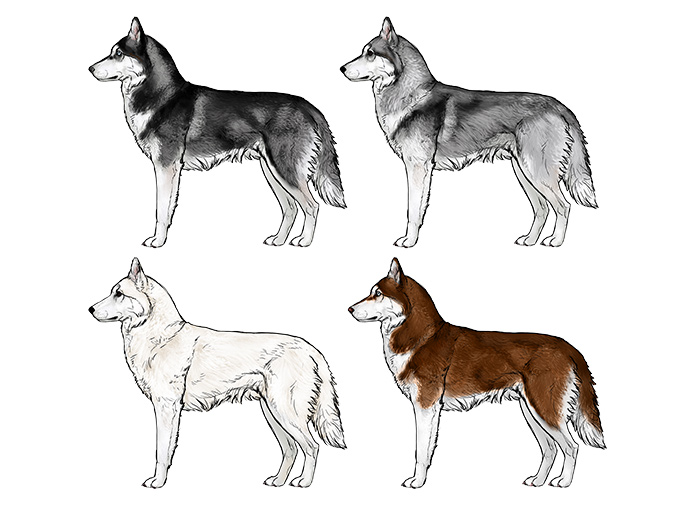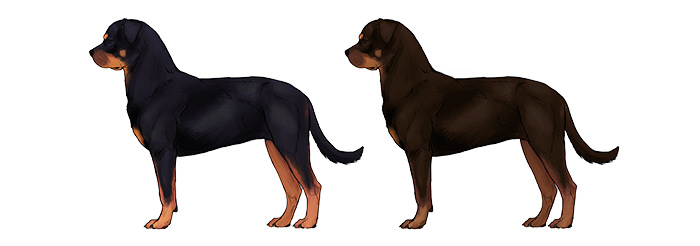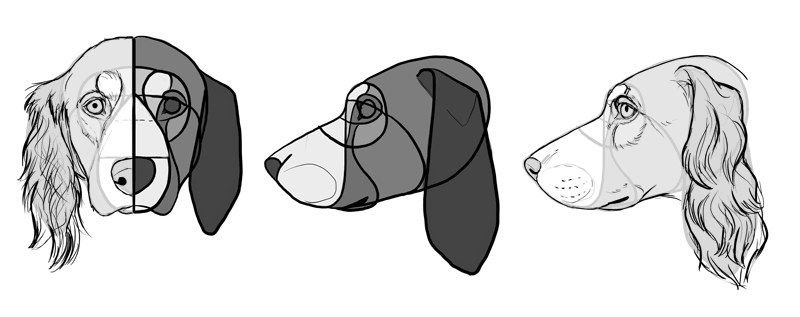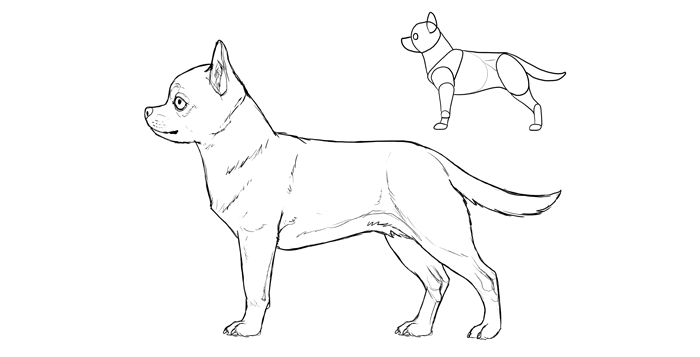This post has been originally commissioned for SketchBook Blog in 2016. After the site’s migration, the original is no longer available, but you can still access the content here. Enjoy!
Last time we learned How to Draw Wolves. Today… we’ll be still drawing them, because dogs are actually domesticated wolves! This means you already know the fundamentals of how to draw a dog, but we need to add some more information to it. This is because in the process of artificial selection dogs have gained special features that you won’t find in wolves. By learning about dogs in general, as well as the specific breeds, you can learn a lot about evolution and creating new realistic species in creature design.
Disclaimer: This is a continuation of How to Draw Wolves. Please check out that tutorial first to understand this one fully.

Wolf vs. Dog
If you saw my tutorial How to Draw Big Cats, this should be easy for you. Dogs, in general, look a bit like a hybrid between a wolf and some big cat. They have muscular, proportional legs, and a harmonious silhouette. They have a well developed chest, and because the legs are not kept so close together, the paws can stay in line. Notice the head and tail position as well.


Dogs can have very different paws depending on the breed. The general rule is that wolf paws look more “bony,” with the middle fingers clearly longer, and very long, dark claws. Dogs very often have pink claws, shorter and more hidden in fur. Because the middle fingers are not as long, the whole paw seems rounder. In many dogs the dew claw is also removed, because it’s not fully functional and thus prone to injury.


There’s not a single recipe for a dog’s body, but each breed is based on the same scheme. You need to start with the “bones”…

… and then add the body:

We didn’t care about the actual muscles in wolves in the last tutorial, because they’re so fluffy that this part of anatomy is not so important. However, dogs can have various types of fur, and some are so short-haired that you can actually see the outline of the muscles. You don’t need to memorize the scheme below, but it’s good to be familiar with it. Use it as a reference every time you draw a dog, and one day you’ll notice you don’t need it anymore!


The biggest difference between wolf and dog lies in the face. When you look at a wolf, “pride” and “intelligence” come to mind. In dogs that most prominent feature is “curiosity.” They seem to be more open to contact with humans (which they actually are) with a couple of features:
- If the ears are stiff, they’re visibly pointed, with little fur inside. Even the furriest breeds don’t have as furry ears as wolves.
- There’s usually a “stop” in the forehead.
- Their eyes seem larger, with not so dark outlines.
- Some breeds have floppy ears, which is unique in the animal world for adult animals.
- The skin around the mouth is very loose, so the lower jaw seems hidden under the upper lips.
- The corners of the lips seem drooping when the mouth is closed.

Let’s take a closer look at these details now. The eyes are the most important here. As you may remember from the last tutorial, wolves (1) have a visibly black outline of the eye. Along with the black third eyelid (a thin membrane that covers the eye when the eyelids are closed) and a black corner of the eye it makes the eye look quite small. Dogs (2) have optically bigger eyes, with a bright third eyelid and not so dark outline of the eye.
Another thing: Wolves tend to have bright eyes with visible pupils (but never blue). Dogs very often have dark brown eyes (3) that make the pupils invisible from a distance.

The floppy ears may seem difficult to draw, but they’re actually pretty simple. They’re floppy for one reason: the cartilage on the base of the ear is not hard enough to support them. So just draw a pointed ear, cross it with a line on the base, and let it fall with the power of gravity!

Last thing: The drooping mouth is a very distinctive dog feature, creating that characteristic wide smile. Once you understand it, you can easily turn a wolf head into a friendly dog!

Because there is no “default dog” with all the doggy features, we need to take a closer look at specific breeds to learn more about dogs. Of course, I can’t describe them all, so I’ve chose ten breeds we’ll analyze closely.
Siberian Husky
Let’s start with a breed that superficially resembles wolf the most. Husky has all the dog features we’ve just talked about mixed with a classic wolf look. So this should be the easiest to draw for the start.

Let’s take a closer look at the head. For most people this is the head of a wolf, but you should be able to see the difference: the pointed, not very fluffy ears, shorter muzzle, and big eyes without a wide outline. The round markings above the eyes can be very big and distinctively colored. The lips are drooping very slightly, so huskies are similar to wolves in this regard as well.

Huskies can have similar markings around the shoulder as wolves, but their fur is usually not banded, and there’s a clear, sharp border in the pattern. Some huskies have beautiful, clear blue eyes!

German Shepherd
Now we’re going farther away from a wolf look, but still staying quite close. German shepherd has more elongated body than husky, and it’s also been bred for a sloping back.

The head is also very much wolf-like, except the muzzle is pretty wide and slightly humpy. Notice the huge ears and the lips drooping more than in the husky.

There are many beautiful color combinations for German shepherds!

Labrador Retriever
Now we’re getting close to a more classic “dog” look. The floppy ears of Labradors make them look cute and very much not-wolf-like. Cover the head and the tail to see the silhouette better—this is a very generic body of a dog, a good base for any breed you’d like to create.

Same with the head—it’s a fully dog head with all the features included: short muzzle, floppy ears, big eyes, and drooping lips going below the lower jaw.

Labradors don’t have many official colors: gold, chocolate, and black are all you can use.

Rottweiler
Rottweiler looks like a “lab on steroids.” Strong, heavily built, with wide chest and jaws, Rottweilers are living proof that floppy ears are not enough to call a dog cute.

Rottweilers have a round head and a short muzzle with strong jaws and heavily drooping lips.

There’s only one officially recognize color for Rottweilers, but a rare red variation does sometimes occur.

Boxer
Boxers have muscular, lean bodies, with long legs and wide torso. Their tails are traditionally cropped as well, but there’s also a variation that’s born with a stump of tail.

Boxers have a very short muzzle with an underbite—the lower jaw closes on the upper one in the front which creates a characteristic profile. The lips are very heavily drooping, making the muzzle look larger than it really is. Whole skin on the face is sagging, along with the eyelids that can reveal the white of the eye. The ears are floppy when kept natural, but when they’re traditionally cropped, they are very triangular and straight.

The most traditional colors for a boxer are tan and white, but it’s not the only combination:

Border Collie
Let’s take a look at a long-haired breed now. Despite that amount of fur, border collies look nothing like wolves. Notice the relatively short legs and long body.

The muzzle is “sharp”, medium long, with only slightly drooping lips. The ears can be straight or semi-erect.

There are a few color variations for a border collie, with black-tan-white and black-white being the most popular. Bright blue eyes can also occur in this breed.

English Cocker Spaniel
Some dogs have been bred so heavily that they look like a wholly different species. Notice how the proportions of the body have been changed to fit a smaller size.

Cocker spaniels have a long, but also wide muzzle with drooping lips. The ears are very long and look even longer when covered with long hair.

The most popular color for a cocker spaniel is golden, but there are more:

Dachshund
This one has such a specialized body that it looks almost caricatural. Notice how close the torso is hanging over the ground, and how much longer the legs would need to be for a more proportional silhouette.

The head has a long, sharp muzzle with slightly drooping lips. The ears are long and floppy.

There are many colors to choose from:

Greyhound
Let’s continue with extreme body shapes! Greyhounds are like the cheetahs of dogs. Very long legs, a clear waist, and long, thin neck. The musculature is clearly visible and crucial to a greyhound look.

The head has a streamlined shape, with a very long, thin muzzle and only slight drooping. The ears are floppy and can get semi-erect when the animal is excited.

There are many colors to choose from!

Chihuahua
Now, the most extreme case of them all. Chihuahua is a tiny wolf, the size of a puppy. To draw a proper chihuahua body just draw a “normal” dog body and add a big head with huge eyes it.

The head has huge eyes and ears, and a tiny nose, giving a chihuahua a very cute appearance. There’s a very clear stop in the forehead, and the muzzle is very short.

Chihuahua is a tiny wolf, the size of a puppy. To draw a proper chihuahua body just draw a “normal” dog body and add a big head with huge eyes.
There are many colors for a chihuahua!

How to Draw Dogs in Practice
All right, but that was theory. Let’s see how to draw a dog step by step. I drew my dogs in SketchBook Pro, but you can use any tool you want.
Start with a simplified skeleton that will define the pose. It’s good to use a reference for this step, or at least practice drawing “skeletons” from photos before you start a serious drawing. Adjust the proportions to the breed you’re drawing.

Add the body parts and draw the guide lines for the head. The head doesn’t need to be perfect—people recognize the breeds mainly by colors and proportions of the body. The subtleties of the face are not as important. For example, if you draw a “wolf” head with short, wide mouth, drooping lips and floppy ears, and attach it to a stocky body, people will recognize a Rottweiler.

Draw the final lines. If the breed is short-haired, draw the outline of the muscles with short lines. If it’s long-haired, draw “waves” of fur as you would with a wolf.

Finally, add the colors and shading. In SketchBook Pro I used the Synthetic Bristle Round Brush to create a fur effect.

That’s All!
This is the end of this tutorial, but not the end of learning! Understanding is the first step to drawing beautiful dogs from imagination, but another step is practice. You need to draw a lot of dogs from photos and real life, applying the knowledge you acquired today to your studies.


3 Comments